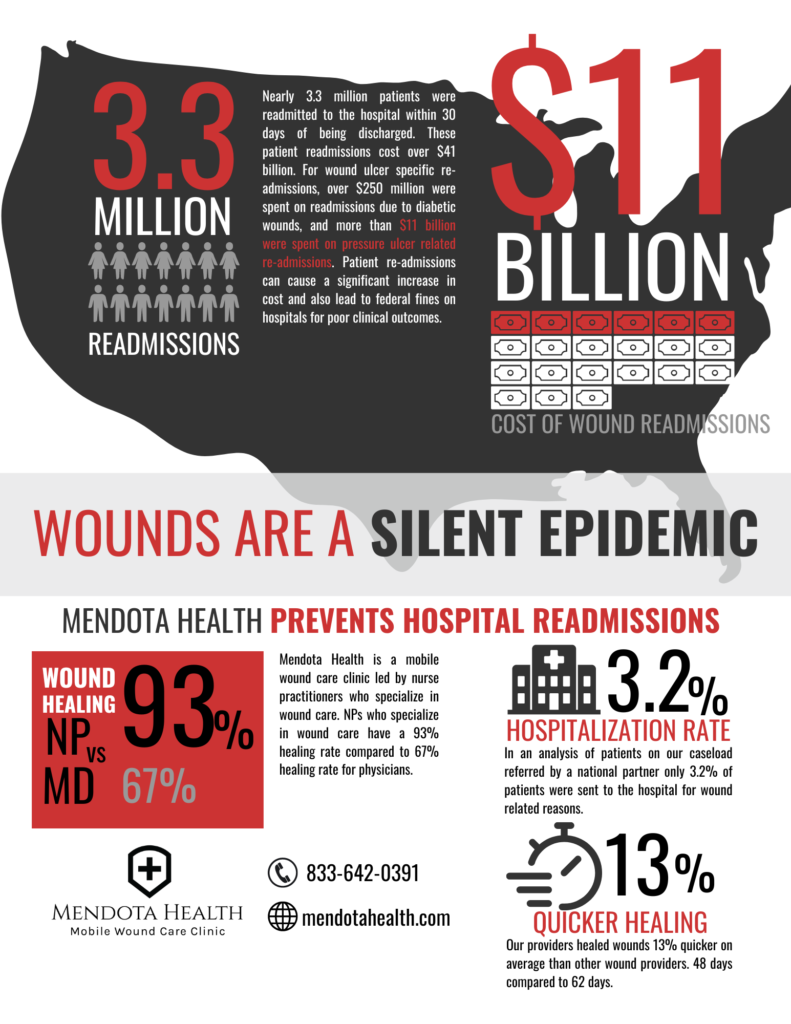
31 Jul Silent Epidemic: Chronic Wounds
In the United States, a silent epidemic lurks within the healthcare system – wounds and chronic wounds. Despite being a prevalent issue, it often goes unnoticed, overshadowed by more well-known health concerns. Wounds, particularly chronic wounds, contribute significantly to hospital readmissions, burdening patients and the healthcare system alike.
The Prevalence of Wounds and Chronic Wounds
Wounds are a common health problem, and their impact can range from mild inconvenience to life-threatening complications. While acute wounds generally heal within a predictable timeframe, chronic wounds are different. Chronic wounds, including pressure ulcers, diabetic foot ulcers, and venous leg ulcers, are notoriously slow to heal and prone to infection. These wounds often linger for weeks, months, or even years if not adequately managed.
Hospital Readmissions and the Cost Burden
Hospital readmissions are a significant concern for both patients and healthcare providers. According to a 2011 study, approximately 3.3 million patients were readmitted to hospitals within 30 days of their initial discharge,. A substantial portion of these readmissions can be attributed to wound-related complications.
Pressure ulcers, in particular, are notorious culprits for hospital readmissions. It is estimated that pressure ulcer-related re-admissions accounted for a staggering $11 billion in healthcare spending. Such financial strain places a heavy burden on the healthcare system and impacts the overall quality of patient care.
Mendota Health Prevents Hospital Readmissions
Mendota Health is a mobile wound care clinic led by nurse practitioners who specialize in wound care. Nurse Practitioners outperform doctors when it comes to healing wounds. Nurse Practitioners have a 93% healing rate compared to 67% for physicians.
By providing advanced wound care in the home Mendota Health reduces hospitalizations due to wounds. In an analysis of patients on our caseload referred by a national partner, only 3.2% of patients were sent to the hospital for wound related reasons. In addition, Mendota Health providers healed wounds 13% quicker on average than other wound care providers.

General Factors Contributing to Readmissions
Several factors contribute to the high rate of readmissions related to wounds and chronic wounds:
- Aging Population: The aging population in the United States is more susceptible to chronic health conditions, which can lead to the development of chronic wounds.
- Chronic Diseases: Conditions like diabetes and peripheral artery disease are prevalent in the U.S. and can impair wound healing, making patients more prone to chronic wounds.
- Limited Awareness: Lack of awareness among patients and caregivers about wound management and prevention can lead to delayed treatment and recurring wounds.
- Inadequate Wound Care: Improper wound care during hospitalization and after discharge can hinder the healing process and increase the risk of complications.
- Healthcare Disparities: Socioeconomic factors can influence access to quality wound care, leading to disparities in outcomes.
How We Can Address the Issue
To combat the silent epidemic of wounds and chronic wounds, a multi-faceted approach is needed:
- Education and Awareness: Raising awareness about wound prevention and management is crucial. Patients and caregivers must be educated about the importance of early intervention and proper wound care techniques.
- Improved Hospital Protocols: Healthcare facilities should implement comprehensive wound care protocols to ensure that patients receive the best possible care during their stay and after discharge.
- Advanced Wound Care in the Home: Post-discharge, patients with chronic wounds should receive the advanced wound care they need to heal. Expert wound care provided by nurse practitioners in the home will dramatically reduce hospital readmissions caused by wounds.
- Research and Innovation: Investment in wound care research and technological advancements can lead to better treatment options and faster healing rates.
Wounds and chronic wounds are indeed a silent epidemic in the United States, exacting a heavy toll on patients’ well-being and the healthcare system’s resources. The high rate of readmissions, coupled with the significant financial burden, underscores the urgency of addressing this issue. By focusing on education, improved hospital protocols, enhanced home care, and continued research, we can take meaningful steps towards reducing the impact of wounds and chronic wounds, improving patient outcomes, and easing the strain on the healthcare system.
Case Study: Wounds for 11 years
Read a case study of a woman who had wounds for 11 years and how a Mendota Health nurse practitioner worked with her to heal them.

